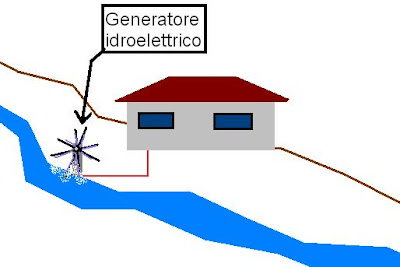
hydroelectric technologies have a good development in terrestrial applications, ie using the water cycle, evaporating from the sea, is transported to the mountains where the clouds descend to the valley allowing the interception of its energy kinetics, these applications are as follows, still good scope for development, very interesting but still under development are technologies that hide huge potential tidal energy.
Hydroelectric plants are currently operating the mechanical potential energy contained in a flow of water that is available at a certain height from the level where the turbines. Therefore, the power of a hydraulic system depends on two terms: the jump (difference exists between the share to which the available water resource flared and the level at which it is returned after passing through the turbine) and scope (the mass Water flowing through the machine, expressed per unit of time).
plants are natural reservoir (lake) or artificial, as in the case of many reservoirs, ponds are sometimes where you increase the capacity with dams, in many cases the barriers consist of many tens of meters high dams.
Plant Flow regoato (a basin)
are today's most powerful hydroelectric plants and the most exploited, have a significant impact on the environment, can be used as "accumulators" of energy use during peak hours pumping water from downstream to upstream
at night are provided with a storage capacity of the outlet stream tending to modify the ports used by the central regime, these plants are generally higher than 10 MW of power and come to such enormous power plant of Itaipu in Brazil, has a basin with an area of \u200b\u200b1460 square kilometers (4 times the lake Garda)
reservoir or accumulator plants are plants with all
the characteristics of traditional plants but that derive the greater availability of water in the tank by lifting electro (with pumps or with the same turbine manufacturing). This type of system consists of two end tanks, placed at different heights, connected by the artifacts of a typical hydroelectric plant: during the day of highest demand (peak), the user water stored in the upper reservoir is used to the production of electricity; in times of low demand (at night) the same is raised to the upper reservoir. In this way the use of electricity to pump water into the upper reservoir is returned almost entirely in the form of a higher quality because back in the hours of greatest demand.
The spread of a large number of these plants, although medium-sized and small, on the one hand would allow greater retention of water in the area, which is always useful, and on the other side the opportunity to mitigate flooding in the case of heavy rainfall the reservoirs would be filled without the need to pump water from downstream to upstream, in these cases there is a net gain of electricity. Hydroelectric plants a tank or storage are currently the best system of energy storage, if such systems were adopted this would allow a larger number on the one hand the need for fewer power plants, which are now necessary to meet the needs of the tip, from ' On the other hand would allow maximum efficiency of power plants and also the same river plants and wind power systems, solar systems and derived from renewable energy sources in general.
plant-river hydroelectric plants
a tank or storage are currently the best system of energy storage, if such systems were adopted this would allow a larger number on the one hand the need a smaller number of power plants, which are now necessary to meet the needs of the tip, on the other hand, allow maximum efficiency of power plants and also the same river plants and wind power systems, solar systems and derived from renewable energy renewables in general.
0 comments:
Post a Comment